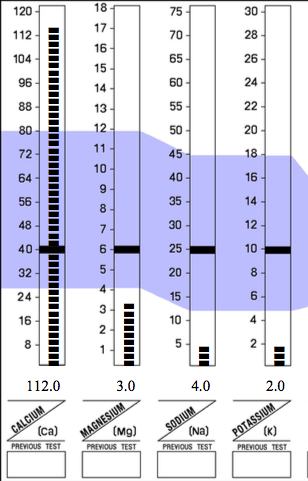Carolyn Dean (M.D., N.D.) could not have summarized it better when she called her book “The Magnesium Miracle.” Because that’s it, a miracle mineral. In the forthcoming newsletters, we will explain more about the enormous importance of Magnesium. When we talk about Magnesium we can not forget Calcium at the same time. Dr. Paul Eck, the founder of the Haarmineralen analysis, did that very well when stressing that the ratios between different minerals in the hair are even more important than the absolute measured concentrations. The Calcium / Magnesium ratio plays a crucial role in the interpretation of the HMA. The mineral profile as determined in the hair is a reflection of the state of the minerals at the cellular level. Paul Elk has been searching for correlations between this mineral profile and all kinds of system variables decades ago. In that he had his time far ahead. He realized that the translation should, if possible, be made ‘bottum up’ to the regulatory systems and on various points he succeeded. As a result, mineral profiles in the HMA deliver a wealth of information at one glance, for the experienced professional.
In addition, an example of a macro mineral profile of a 12 year old girl with anxiety and panic disorders:

The coherence of this profile is of great importance, as it has been given a self-evident approach within the system approach. High Calcium and low Magnesium, as well as low Sodium and Potassium, form a coherent profile with a wealth of information.
An excessive Calcium value in the hair indicates an elimination of biologically non-useable calcium. We know Calcium in two forms in the body, biologically usable and non-usable. The latter form refers to deposits of Calcium in the tissues (among other things known from the term “venous artery”). Calcium is a predominantly extracellular mineral, that is, the concentration in the extracellular space (between the cells) many times, to more than a factor 10,000 higher than the concentration in the cell. For Magnesium, the reverse applies, which is a primary an intracellular mineral. The concentration of Magnesium in the cell is very important tp keep Calcium ‘outside’ the cells. Too much Calcium in the cell is a physiologically highly undesirable situation with numerous pathological expressions.
Magnesium is very important to keep Calcium in the biologically active dissolved form. In the absence of Magnesium, Calcium is converted to calcium deposits. Not a coincidence that a rapid and effective increase in Magnesium concentration in the cells is an important rate determining step in virtually every recovery process. With this girl, the fear and panic disaster was rapidly reduced by the intake of Magnesium with very high bioavailability.
More about the special function of Magnesium and the way to effectively supplement Magnesium in the webinar which can be found on our website (accessable for health professionals).






